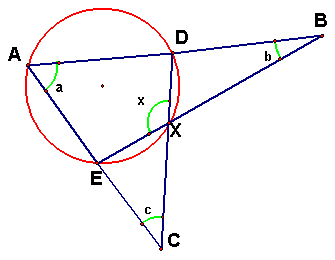Reading angles as arcs! |
|||||||||||
|
Definition It
is interesting to read angles as arcs. But first we have some agreement. In
order to write arcs easily we use the anti-clockwise
direction. We define: ÐAOB » arc AB reflex
ÐAOB » arc BA Note : (1) arc AB ¹ arc BA (2) The symbol “»” is not equality but only
“supposed to be equivalent to” (3) We use the same symbol for backward
operation, i.e. arc
AB » ÐAOB |
|
||||||||||
|
There are five common
types of angles connected with theorems on circles. They are listed below as
arcs. Do you know why they are defined like that? Find out yourselves. Hint for (3) below: exterior angle of triangle. |
|||||||||||
|
(1) Angle at circumference
ÐACB » ½ arc AB |
(2)
Tangent angles
ÐBAC » ½ arc AB ÐBAD » ½ arc BA |
||||||||||
|
(3) Intersecting chords
ÐAED » ½ (arc AD + arc BC) ÐBED » ½ (arc CA + arc DB) |
(4) Chords intersect outside circle
ÐCAE » ½ (arc CE - arc DB) |
(5) Two tangent lines
ÐBAC » ½ (arc BC - arc CB) |
|||||||||
|
Purpose The
purpose of defining like this is to read angles as if they are arcs. Can you draw diagrams to
show some of the theorems on circle?
|
|||||||||||
|
Example 1 In the right diagram, CA
and CB are tangents to the circle. Find z in terms of x and y. Solution z » ½ (arc BA – arc AB) » ½ (arc BD + arc DA – arc AB) » x + y – w = x + y – (180° - x – y) = 2(x + y) – 180° |
|
||||||||||
|
Example 2 In the figure in the
right, ADB, AEC, CXD, BXE are
straight lines. A, E, X, D are concyclic. Find x in terms of a, b, c. Solution b » ½ (arc AE – arc XD) (1) c » ½ (arc DA – arc EX) (2) (1) + (2), b + c » ½ [arc AE + arc DA – (arc XD + arc EX)] =
½ [arc DE – arc ED] » x – a \ x = a + b + c |
|
||||||||||
|
Conclusion Although
reading angles as arcs technique seems not a standard way in proving circle problems,
it is very helpful especially in multiple-choice questions. |
|||||||||||







